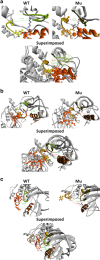A novel kinase mutation in VEGFR-1 predisposes its αC-helix/activation loop towards allosteric activation: Atomic insights from protein simulation
- PMID: 27049304
- PMCID: PMC4989210
- DOI: 10.1038/ejhg.2016.26
A novel kinase mutation in VEGFR-1 predisposes its αC-helix/activation loop towards allosteric activation: Atomic insights from protein simulation
Abstract
Vascular endothelial growth factor receptor 1 (VEGFR-1) has been implicated in diverse pathologies, including cancers. Although VEGFR-1 is considered as functionally impaired kinase, its decoy characteristics make it an important regulator of VEGFR-mediated signaling, particularly in tumor angiogenesis. VEGFR-1 conveys signaling via its tyrosine kinase (TK) domain whose activation is regulated by phosphorylation of specific tyrosine residues. Thus dysregulation of VEGFR-1 signaling, as reported in most of the cancers, might be a consequence of altered phosphorylation that could be attributed to genotypic variations in its TK domain. Considering the importance of TK domain of VEGFR-1, we carried out its mutational screening in 84 clinically validated and histopathologically confirmed colorectal cancer patients. By means of direct DNA sequencing and SNP analyses, eight novel variations, including one synonymous, two deletion, one missense and four intronic variations, were reported in the TK domain of VEGFR-1. rs730882263:C>G variation specifically reported in colon cancer, representing a single-atomic change (Sulfur to Oxygen) in the predicted (p.Cys1110Ser) protein, was observed as potentially deleterious variation as assessed by multiple single-nucleotide polymorphism prediction servers. Molecular dynamics simulations of VEGFR-1 Wt and (p.Cys1110Ser) variant models revealed major conformational changes in variant protein presumptuously generating an open conformation thereby exposing the activation domain and consequently increasing the probability of phosphorylation events: a condition frequently reported in cancers.
Figures





Similar articles
-
Vascular endothelial growth factor receptors: molecular mechanisms of activation and therapeutic potentials.Exp Eye Res. 2006 Nov;83(5):1005-16. doi: 10.1016/j.exer.2006.03.019. Epub 2006 May 19. Exp Eye Res. 2006. PMID: 16713597 Free PMC article. Review.
-
A single amino acid substitution in the activation loop defines the decoy characteristic of VEGFR-1/FLT-1.J Biol Chem. 2006 Jan 13;281(2):867-75. doi: 10.1074/jbc.M506454200. Epub 2005 Nov 14. J Biol Chem. 2006. PMID: 16286478 Free PMC article.
-
Comprehensive structural and functional analysis of hVEGFR1: Insights into phosphorylation, molecular interactions, and potential inhibitors through docking and dynamics simulations.Cancer Treat Res Commun. 2024;39:100795. doi: 10.1016/j.ctarc.2024.100795. Epub 2024 Feb 23. Cancer Treat Res Commun. 2024. PMID: 38428067
-
Hypoxia-induced epithelial VEGF-C/VEGFR-3 upregulation in carcinoma cell lines.Int J Oncol. 2008 Mar;32(3):585-92. Int J Oncol. 2008. PMID: 18292935
-
The ErbB/HER family of protein-tyrosine kinases and cancer.Pharmacol Res. 2014 Jan;79:34-74. doi: 10.1016/j.phrs.2013.11.002. Epub 2013 Nov 20. Pharmacol Res. 2014. PMID: 24269963 Review.
Cited by
-
Aqueous solution interactions with sex hormone-binding globulin and estradiol: a theoretical investigation.J Biol Phys. 2018 Dec;44(4):539-556. doi: 10.1007/s10867-018-9505-8. Epub 2018 Jul 5. J Biol Phys. 2018. PMID: 29974373 Free PMC article.
-
Structural Basis for Vascular Endothelial Growth Factor Receptor Activation and Implications for Disease Therapy.Biomolecules. 2020 Dec 15;10(12):1673. doi: 10.3390/biom10121673. Biomolecules. 2020. PMID: 33333800 Free PMC article. Review.
-
Structural insight into mutations at 155 position of valosin containing protein (VCP) linked to inclusion body myopathy with Paget disease of bone and frontotemporal Dementia.Saudi J Biol Sci. 2021 Apr;28(4):2128-2138. doi: 10.1016/j.sjbs.2021.02.048. Epub 2021 Feb 19. Saudi J Biol Sci. 2021. PMID: 33911929 Free PMC article.
-
Therapeutic advances of targeting receptor tyrosine kinases in cancer.Signal Transduct Target Ther. 2024 Aug 14;9(1):201. doi: 10.1038/s41392-024-01899-w. Signal Transduct Target Ther. 2024. PMID: 39138146 Free PMC article. Review.
-
Quercetin suppresses ROS production and migration by specifically targeting Rac1 activation in gliomas.Front Pharmacol. 2024 Jan 31;15:1318797. doi: 10.3389/fphar.2024.1318797. eCollection 2024. Front Pharmacol. 2024. PMID: 38362155 Free PMC article.
References
-
- Shibuya M: Role of Vegf-Flt receptor system in normal and tumor angiogenesis. Adv Cancer Res 1995; 281–316. - PubMed
-
- Dvorak HF: Vascular permeability factor/vascular endothelial growth factor: a critical cytokine in tumor angiogenesis and a potential target for diagnosis and therapy. J Clin Oncol 2002; 20: 4368–4380. - PubMed
MeSH terms
Substances
LinkOut - more resources
Full Text Sources
Other Literature Sources
Medical

